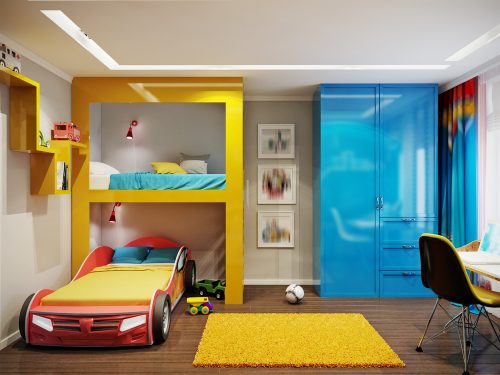A Guide to Different Types of Beds

The different types of beds that currently exist on the market can be adapted to the distinct needs and specifications of each person.
Choosing the type of bed that you will use is very important, as it will directly affect the quality of your sleep.
Your rest is a serious matter. You should therefore choose a bed that will suit your needs, but also your personal characteristics.
For example, if you’re very tall you will need a longer than normal bed.
In this article today we will talk about different types of beds that you can find on the market. We will also give you some basic advice to choose a bed correctly.
The types of beds, basically, can be classified according to size and structure.
Types of beds according to size
This is perhaps the most well known and common classification of beds. However, the size is important to take into account because, besides having a decorative element, it should be functional to enable you to rest.
In the first place, we find the basic or single bed. Generally these measure 90cm x 200cm.
The next bed is a double bed. Within this category we find different dimensions, as follows:
- Standard double bed, 135-140cm x 200cm
- Queen size, 160cm x 200cm
- King size, 190cm x 200cm, this one being the largest.
When choosing the size of your bed, you should take into account the size of the room and also its height. If you’re not too tall for a standard bed, whichever size is fine.
However, if you are very tall, it would be good to look for a longer bed. The ideal bed is where you can stretch yourself out at full length without your feet hanging over the edge.
Types of beds according to their structure
The structure of the bed, besides being a fundamental element, has 2 objectives: to be functional, and to be an element that forms part of your decor.
Consequently, there are 2 types of beds according to their structure:
Beds with a compact structure
This type of bed is perfect if what you want is to make the best of the space available. Beds with a compact structure are:
Hidden structure
The legs of the bed aren’t visible, but rather are hidden behind a solid structure, usually covered with cushioned fabric. Generally this type of bed uses the solid structure to create a storage space underneath.
Bunk beds
This type of bed is usually found in children’s rooms where there isn’t much space.
The purpose of bunk beds is to take advantage of the vertical space, since horizontal space is somewhat lacking.

Fold up beds
This type of bed unfolds from a closet or from the wall. It’s a very practical solution, for example for a study that can be made into a guest bedroom as needed.
Truckle beds
Together with bunk beds and folding beds comes another classic and easy option to the lack of space.
These beds normally come in pairs, with one below the other that can be pulled out like a drawer.
Depending on their design they can be very useful to take advantage of the space you have available.
Loft beds
This type of bed is the most innovative, and definitely one of the less common types.
It has to do with making a distinct and functional space beneath the bed, which is set at bunk bed height or a little lower. If you choose this type of bed you could put a couple of benches below.
You could take advantage of the space below the bed as a storage space, a space to hang clothes, or even to put a desk or couch.
For a teenager’s room it would be perfect.
Bed structure with storage
This type of bed is similar to the first, with the difference that the storage system is organized around the bed structure, instead of in between the bed base and the floor.
Beds with a light structure
These types of beds are lighter and simpler.
With legs
These are the most classic and simple beds there are. There is a grand variety of fabrication designs and materials, although they are generally made of metal.
Low structure
This type of bed reminds you of oriental style beds. They are perfect for a Zen style.
You should take into account that this type of bed may not be suitable for people with back problems.

Canopy beds
Canopy beds look like they’ve appeared straight out of a fairy tale. They are beautiful and classic, although more and more forward thinking designs are becoming available on the market.
Even so, they only really suit large bedrooms with tall ceilings.
Floating beds
This type of bed is the most modern and contemporary. It has to do with anchoring the bed to the wall, or placing a structure smaller than the bed itself underneath to hold up the bed, so it can’t be seen. The bed itself doesn’t have legs that can be seen, and appears to be floating in mid air.
The visual effect is much better if you also add a point of light below the bed.
Wrought iron beds
Some of its principal characteristics are its strength and its visual delicacy.
They are perfect to go with a rustic or vintage decor, or even an industrial style.

Conclusion
As we’ve seen today there are many types of beds available. The most important thing is to take into account your needs when choosing your new bed. For example if the bed is for the children’s bedroom, for guests, if you need to save space, or for extra storage space.
On the other hand, the size of the room is also important. One last thing, remember that the choice of mattress is also fundamental, since the bed and mattress are inseparable complements.
The different types of beds that currently exist on the market can be adapted to the distinct needs and specifications of each person.
Choosing the type of bed that you will use is very important, as it will directly affect the quality of your sleep.
Your rest is a serious matter. You should therefore choose a bed that will suit your needs, but also your personal characteristics.
For example, if you’re very tall you will need a longer than normal bed.
In this article today we will talk about different types of beds that you can find on the market. We will also give you some basic advice to choose a bed correctly.
The types of beds, basically, can be classified according to size and structure.
Types of beds according to size
This is perhaps the most well known and common classification of beds. However, the size is important to take into account because, besides having a decorative element, it should be functional to enable you to rest.
In the first place, we find the basic or single bed. Generally these measure 90cm x 200cm.
The next bed is a double bed. Within this category we find different dimensions, as follows:
- Standard double bed, 135-140cm x 200cm
- Queen size, 160cm x 200cm
- King size, 190cm x 200cm, this one being the largest.
When choosing the size of your bed, you should take into account the size of the room and also its height. If you’re not too tall for a standard bed, whichever size is fine.
However, if you are very tall, it would be good to look for a longer bed. The ideal bed is where you can stretch yourself out at full length without your feet hanging over the edge.
Types of beds according to their structure
The structure of the bed, besides being a fundamental element, has 2 objectives: to be functional, and to be an element that forms part of your decor.
Consequently, there are 2 types of beds according to their structure:
Beds with a compact structure
This type of bed is perfect if what you want is to make the best of the space available. Beds with a compact structure are:
Hidden structure
The legs of the bed aren’t visible, but rather are hidden behind a solid structure, usually covered with cushioned fabric. Generally this type of bed uses the solid structure to create a storage space underneath.
Bunk beds
This type of bed is usually found in children’s rooms where there isn’t much space.
The purpose of bunk beds is to take advantage of the vertical space, since horizontal space is somewhat lacking.

Fold up beds
This type of bed unfolds from a closet or from the wall. It’s a very practical solution, for example for a study that can be made into a guest bedroom as needed.
Truckle beds
Together with bunk beds and folding beds comes another classic and easy option to the lack of space.
These beds normally come in pairs, with one below the other that can be pulled out like a drawer.
Depending on their design they can be very useful to take advantage of the space you have available.
Loft beds
This type of bed is the most innovative, and definitely one of the less common types.
It has to do with making a distinct and functional space beneath the bed, which is set at bunk bed height or a little lower. If you choose this type of bed you could put a couple of benches below.
You could take advantage of the space below the bed as a storage space, a space to hang clothes, or even to put a desk or couch.
For a teenager’s room it would be perfect.
Bed structure with storage
This type of bed is similar to the first, with the difference that the storage system is organized around the bed structure, instead of in between the bed base and the floor.
Beds with a light structure
These types of beds are lighter and simpler.
With legs
These are the most classic and simple beds there are. There is a grand variety of fabrication designs and materials, although they are generally made of metal.
Low structure
This type of bed reminds you of oriental style beds. They are perfect for a Zen style.
You should take into account that this type of bed may not be suitable for people with back problems.

Canopy beds
Canopy beds look like they’ve appeared straight out of a fairy tale. They are beautiful and classic, although more and more forward thinking designs are becoming available on the market.
Even so, they only really suit large bedrooms with tall ceilings.
Floating beds
This type of bed is the most modern and contemporary. It has to do with anchoring the bed to the wall, or placing a structure smaller than the bed itself underneath to hold up the bed, so it can’t be seen. The bed itself doesn’t have legs that can be seen, and appears to be floating in mid air.
The visual effect is much better if you also add a point of light below the bed.
Wrought iron beds
Some of its principal characteristics are its strength and its visual delicacy.
They are perfect to go with a rustic or vintage decor, or even an industrial style.

Conclusion
As we’ve seen today there are many types of beds available. The most important thing is to take into account your needs when choosing your new bed. For example if the bed is for the children’s bedroom, for guests, if you need to save space, or for extra storage space.
On the other hand, the size of the room is also important. One last thing, remember that the choice of mattress is also fundamental, since the bed and mattress are inseparable complements.







